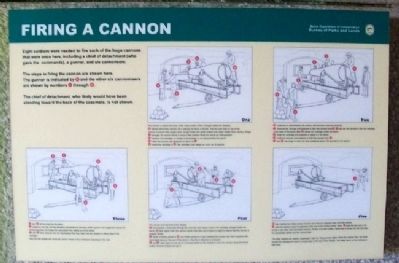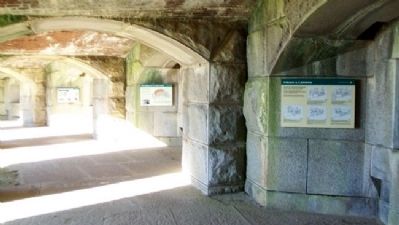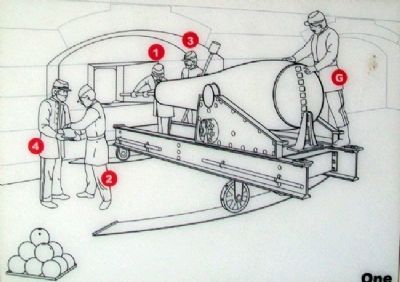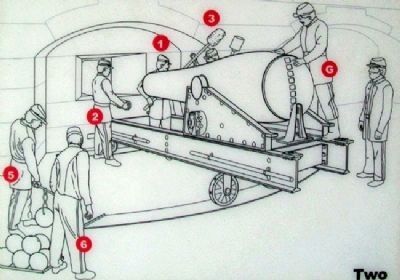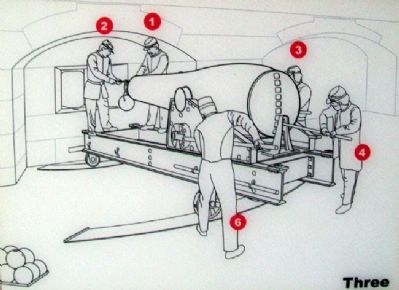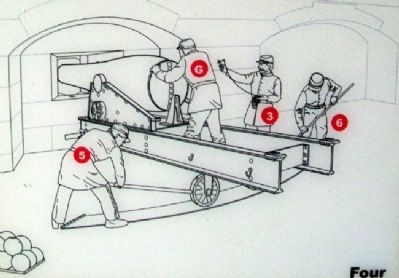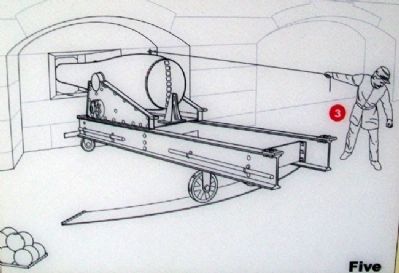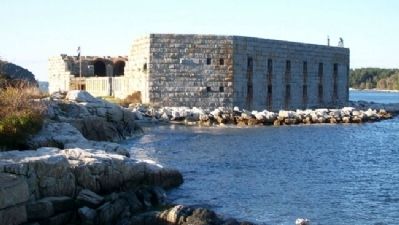Near Phippsburg in Sagadahoc County, Maine — The American Northeast (New England)
Firing a Cannon
Eight soldiers were needed to fire each of the huge cannons that were once here, including a chief of detachment (who gave the commands), a gunner, and six cannoneers.
The steps in firing the cannon are shown here. The gunner is indicated by "G" and the other six cannonneers [sic] are shown by numbers "1" through "6".
The chief of detachment, who likely would have been standing toward the back of the casemates, is not shown.
[Cannon Firing Step Diagram Captions Follow]
One
The cannon is toward the back of the lower portion of the carriage (called the chassis)
"G" stands behind the cannon; he is placing his hand, or thumb, over the vent hole on top of the cannon to ensure that oxygen does not get inside and ignite embers that might remain from previous firing
"1" sponges the cannon barrel to ensure that embers inside the barrel are extinguished
"2" receives the cartridge, or charge of gunpowder, to be placed inside the barrel
"3" holds the rammer and prepares to hand it to "1"
"4" hands the charge to "2"; the cartridge could weigh as much as 18 pounds
Two
"G" continues to stand behind the cannon with his hand over the vent hole.
"1" removes the sponge and prepares to take the rammer from "3"; "1" will use the rammer to ram the cartridge to the base of the barrel after "2" places the cartridge inside the barrel
"2" holds the cartridge and prepares to place it in the barrel
"3" holds the rammer and prepares to take the sponge from "1"
"5" and "6" use tongs to carry the shell (weighing about 100 pounds) to the cannon
Three
"1" and "2" lift the shell into the barrel
"4" inserts an iron bar into the elevating mechanism at the base of the cannon; this angles the cannon for aiming purposes and keeps the cannonball from rolling out of the barrel
"3" and "6" each have an iron bar (handspike) that they insert into the wheels on either side of the carriage; they turn the wheels and move the cannon close to the embrasure (opening) in the wall
Four
The cannon is at the front of the chassis
"G" has inserted a sharp pick through the vent hole and made a hole in the cartridge (charge) inside the barrel; "G" then sights down the cannon barrel (may also use a transit or sight) to assure that the cannon is properly aimed
"3" hands a friction primer to "G"; the friction primer is a wire inserted into a brass tube that is packed with fulminated mercury;
the end of the wire is a ring that is attached to a lanyard
"5" and "6" each have an iron bar in a traverse wheel on the chassis to move the cannon along the tracks (called traverse circles) and aim it.
Five
"G" has inserted the friction primer into the vent hole and stepped away from the cannon
"3" pulls the lanyard, which is attached to the wire in the friction primer; when "3" pulls the wire out of the primer's tube [filled] with fulminated mercury, friction and heat create a flame that is forced into the cartridge; the gunpowder ignites and the cannon fires
The other soldiers are nearby, preparing to start the firing process again. When the cannon fires, the recoil causes the carriage and barrel to travel back to the rear of the chassis. The metal doors on the embrasure slam shut.
Erected by Maine Department of Conservation.
Topics. This historical marker is listed in these topic lists: Forts and Castles • War, US Civil.
Location. 43° 45.301′ N, 69° 47′ W. Marker is near Phippsburg, Maine, in Sagadahoc County. Marker is on a lower casement (gun deck) wall inside Fort Popham State Historic Site, off Popham Road (Maine Route 209). Touch for map. Marker is in this post office area: Phippsburg ME 04562, United States of America. Touch for directions.
Other nearby markers. At least 8 other markers are within 10 miles of this marker, measured as the crow flies. Forts on the Kennebec River (here, next to this marker); The Casemate Key to a Fort's Design (here, next to this marker); Fort Popham: Guardian of the Kennebec (a few steps from this marker); Percival P. Baxter (a few steps from this marker); Sites of Forts in this Area (within shouting distance of this marker); Fort Popham State Historic Site (about 700 feet away, measured in a direct line); Phippsburg Veterans and Mariners Memorial (approx. 4.2 miles away); The Caulkers' Shed (1899) (approx. 9.8 miles away). Touch for a list and map of all markers in Phippsburg.
Also see . . .
1. Fort Popham State Historic Site. (Submitted on February 2, 2012, by William Fischer, Jr. of Scranton, Pennsylvania.)
2. Fort Popham, Maine. (Submitted on February 2, 2012, by William Fischer, Jr. of Scranton, Pennsylvania.)
Credits. This page was last revised on September 23, 2020. It was originally submitted on February 1, 2012, by William Fischer, Jr. of Scranton, Pennsylvania. This page has been viewed 935 times since then and 15 times this year. Photos: 1, 2, 3, 4, 5, 6, 7. submitted on February 3, 2012, by William Fischer, Jr. of Scranton, Pennsylvania. 8. submitted on January 31, 2012, by William Fischer, Jr. of Scranton, Pennsylvania.
